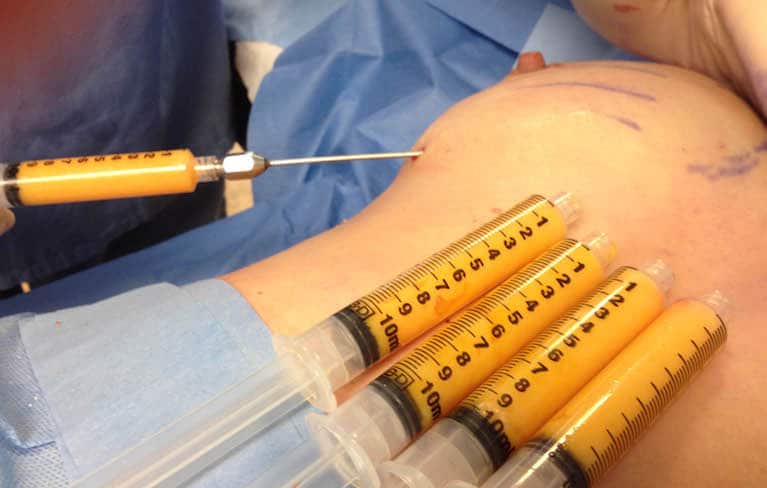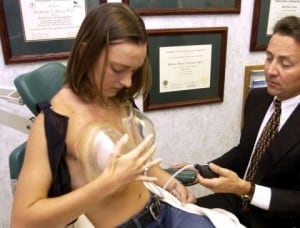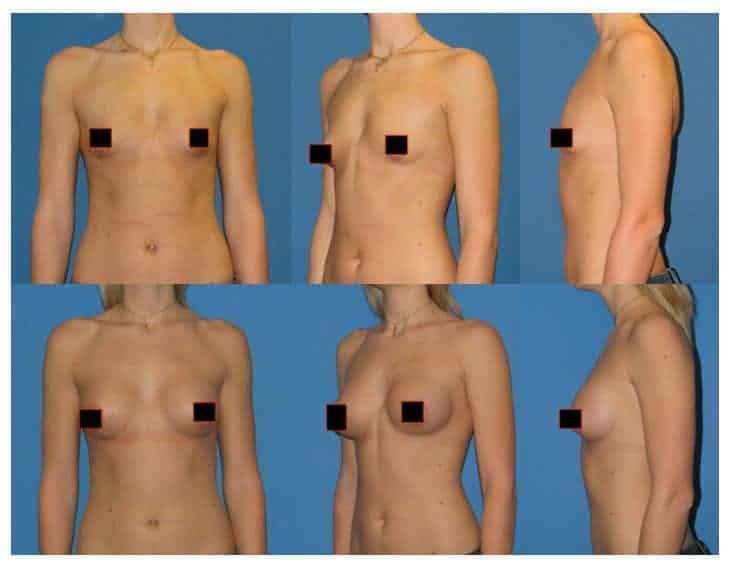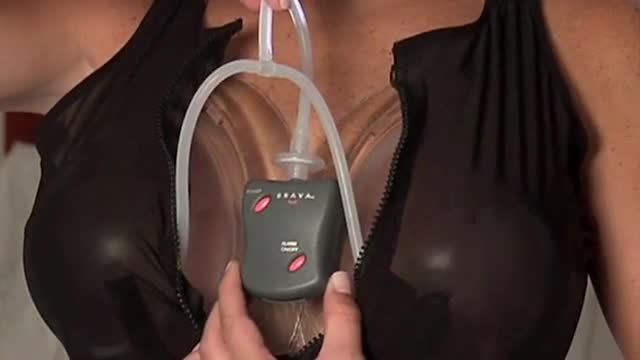Fat Transfer Breast Augmentation: Pros, Cons, Cost and Is It Worth It?
Love the idea of instantly bigger breasts but don’t want to go under the knife? Join the club.
Whereas all natural breast enhancement with pills, pumps and massage works – the downside is that it is not instantaneous. In fact, it’ll take several weeks to start seeing noticeable visible results and a few months to get real growth that’s permanent.
Sure, all the boob growth you get is yours to keep but it does take a lot of patience and dedication.
Which is probably why we get so many emails asking about fat transfer breast augmentation – it’s not quite surgery, it does use your own fat (no foreign objects embedded in your body!), and best of all, it gives you bigger breasts fast. What’s not to love?
Well, it’s not as simple as 1-2-3-C-cups! There are some things you should know about this procedure before you schedule it into your calendar.
Let’s find out more about it, shall we?
What is Fat Transfer Breast Augmentation?
Fat transfer breast augmentation, aka fat grafting, is fast gaining popularity in the United States with 26.6% more procedures done from 2009 to 2010. It’s popular with women who want bigger breasts that look more softer or natural than implants while also avoiding many of the risks involved in getting artificial implants.
In a nutshell, it works like other fat grafting medical procedures – a plastic surgeon gets fat through liposuction from your problem areas such as the stomach, thighs or hips and transfers them to your breasts.

While this procedure has gotten flak from the medical community previously due to concerns that adding fat to your breast might obscure detection of cancerous lumps, the latest studies show that there is little to no risk at all. In fact, it’s easier to detect malignant lumps in fat-grafted breasts than those with silicone or saline implants.
Furthermore, both the American Society of Plastic Surgeons and the American Society for Aesthetic Plastic Surgery already concur that fat grafting is a safe and viable procedure to enhance the appearance of your breasts after breast reconstruction surgery.
So as well as the medical establishment is concerned in terms of safety, breast fat transfer have the green light.
How Exactly is the Fat Transfer to Breasts Done?
When you choose to get a fat transfer to your breasts, you are signing up for a two-step procedure.
The first thing your surgeon will do is to harvest the fat from the areas you’ve chosen. Water-assisted liposuction is the popular method to do this so he can gently remove fat while lessening the cell damage he causes. However, your surgeon can also recommend either an ultrasound-assisted liposuction or a laser one.
To further lessen scars and have a smoother contoured effect from the liposuction procedure, a laser is used as a finishing tool to stimulate collagen production to tighten skin.
Once fat is harvested, it is processed and purified then re-injected back into your breasts. This is where the surgeons experience and expertise are really important.

He or she will inject fat in very little droplets through the multiple layers in your breast so that your breasts will have your desired look while still looking natural. At the same time is is also important that your doctor injects the fat in all the right places so that the new fat cells gets access to blood supply which is a big factor to making sure that the results last longer.
Who Can Get Fat Transfer Breast Augmentation?
As tempting as this fat transfer to breasts might sound – not everyone’s a candidate.
Since the procedure involves harvesting fat from your own body, one of the requirements is to have ample fat stores throughout your body. In typical fat grafting surgeries, about 400-600cc of fat must be grafted into your breasts to increase a cup size.
The most popular areas where doctors harvest this is in the inner or outer thigh. So if you are a thinner person with less than ample body fat – you might have to prepare in order to have this procedure. Specifically, the surgeon might require you to either gain more weight or have multiple donor areas where fat can be harvested.
Breast tissue pliability is also a factor. Those who have had previous pregnancies have more pliability in their boobs so there’s less of a problem.

For other women, doctors sometimes advise you to use the Brava system which is mainly for expanding breast tissue and stretching your skin.
In case you haven’t yet read our post on breast enlargement pumps – the Brava is basically a suction cup-like device that you attach to your breasts for around 10 hours each day before your procedure to encourage your cells to replicate and increase pliability.
Extra perk? The Brava also increases breast size all on its own!
One thing you should definitely know about fat transfer breast augmentation, though, is that it is not a procedure capable of drastically increasing the size of your breast by two or more cup sizes. If you’re hoping to go from AA to DD – fat transfer won’t get you there.
Generally, this procedure is great for going up around one cup size and improving the fullness, softness, and cleavage-ness of your breasts.
How Permanent Are the Fat Graft Results?
Wait…what? Why can’t I just inject a whole bunch of fat into my breasts and go up multiple cup sizes, you ask?
Well, with fat-grafting, doctors usually recommend going up only a cup size, because too much fat injections might just end up getting absorbed by the body negating its effect.
The body reabsorbing fat is also a factor in the procedure’s longevity. It’s a challenge to promise concrete results since there is always the risk that the body will reabsorb the excess fat, especially within the first three months.
To offset fat reabsorption in the first few months after a procedure, doctors often recommend using the Brava system (again) to help expand tissue naturally so that the fat from the procedure integrates into your body. In terms of longer-term fat absorption, there are maintenance injections available to prolong or even achieve a permanent effect from your breast augmentation.
Oh, one thing you should know about Brava is that it’s expensive – like, over $1,000 expensive. If you’re going to opt for one of these, we recommend searching on eBay for gently used Brava systems – you can get a great deal there.
What are the Fat Transfer Breast Augmentation Costs?
Speaking of money, you’ll want to know exactly how much the fat transfer breast augmentation will cost you.
Well, there’s no one set price – the costs vary from city to city, with more urban areas such as New York and LA charging as much as four times more than in smaller cities.
With a fat grafting procedure, you will be shouldering four fees:
- First the cost of the surgeon, which would vary with his or her level of expertise, techniques used, and the results you want to achieve.
- You will also pay for a fat harvest charge which will cover the liposuction and the fat purification process that will be done.
- Third is the cost of anesthesia which can vary based on who administers it (anesthesiologist or a cheaper nurse anesthetist) and the type of anesthesia needed – you don’t want to mess around with being stingy when it comes to anesthesia, by the way.
- Lastly most doctors also charge a facility fee if they are conducting the surgery in a certified surgery center or a hospital instead of in their personal clinics.
Prices also vary based on amount of fat harvested and how much is re-injected. With all these factors, the typical procedure in the United States ranges from $4,000 to $15,000 USD. Of course you can opt to have it done in other countries wherein it’s much much cheaper – hint, hint: Thailand or South Korea.
You can also check your medical insurance if they cover–or even just subsidize–this procedure. Most plans cover breast reconstruction, and fat grafting falls under that. In fact more insurance companies are starting to see the benefit in fat grafting since is requires no hospitalization, and have lower complication rates post-operation.
What are the Pros and Cons of Fat Transfer Breast Augmentation?
Apart from the instant boost in breast size, the most obvious benefit is the natural look and feel of your breasts. Unlike pre-shaped implants, surgeons can sculpt your breasts to the shape you want through strategic placement of injections. There is also minimal scarring with fat grafting versus traditional implants.

As long as the added fat have access to blood supply in your body, it can actually grow and shrink as you put on or lose weight, which adds to the natural look it already has.
Another great benefit with fat grafting is that you don’t put foreign chemicals or objects in your body so the risks of having an allergic reaction or infection is reduced. At the same time, you do not cause a loss of sensation in your breasts or nipples since you’ve only added more of your own fat into your breasts. This procedure also causes less complication when it comes to breastfeeding or mammograms.
Plus, with the liposuction element of the procedure, you also get the bonus of getting to sculpt your body and tone other problem areas while enhancing your breasts. Result = smaller waist and bigger boobs. Win win!
But it’s not all full boobs and fairies here – as with all medical procedures, breast fat transfer comes with downsides as well.
One of the main cons that patients complain about is that immediately afterwards, the breasts look like too much fat is injected and don’t feel as natural as they want. However one thing you have to remember is that the body can reabsorb the fat, so your newly augmented breasts will definitely shrink to a more natural size in the course of three months.
More seriously, there have also been cases where the resulting fat transfer can appear ugly and irregular, but this can easily be mitigated if you choose the a meticulous and highly skilled surgeon. Always, always opt for a surgeon who’s performed the operation successfully many times, even if they have more expensive fees.
In terms of the safety of the procedure itself, there is actually no medical literature that conclusively states that fat grafting for the breasts pose a significant danger to patients. Contrary to this, studies are actually showing that fat transfer can actually be as safe if not safer than breast implants.
Again, however – like any other surgical procedure, this procedure comes with the standard set of risks. The main ones are that the fat harvesting at the beginning of the procedure can put patient at risk of allergic reaction to the anesthesia or burns from the lasers and/or ultrasounds used.
It is imperative that you perform enough research in both the procedure and in the surgeon of your choice so that you can accurately assess (together with your chosen board-certified doctor) all the risks and potential complications involved.
Is it Worth It?
This is the hardest question in this article – and one that we cannot answer because it is one you’ll have to answer for yourself.
The most prohibitive aspect of this procedure is the price so you’ll have to consider whether the significant price of the augmentation is worth the increase you’ll be getting. Keep in mind that the amount of graft take (aka, the amount of fat that stays in your breasts) is approximately 50%, depending on the density of the breasts, vascularity, skin elasticity and processing method of the grafts.
It might also take more than one procedure to get the look and size you want.
Overall, it’s a great procedure for those who can spend the extra money and who’s goal is to only go up a cup size or two.
Want a full guide on getting naturally bigger, fuller breasts – without the risks and costs of medical procedures? Check out the C Cup Code!


